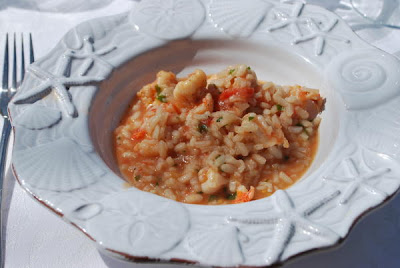A Special Sunday Supper in Memory of
Our Tree
Pot Roast with Potato Gnocchi
*
Grated Zuchini with Parmesan
*
Brocollini with Olive Oil
*
Lemon Meringue Pudding
The majestic, two hundred year old tree that grew in our front yard was the focal point of our home. As you drove in our driveway, the beauty of that tree made our home welcoming and elegant. It was like losing an old friend to see our dear tree toppled over as we came home from our morning walk. He caused no harm to our home, yard or fence as his roots gave way in the saturated soil. He will keep our home warm for many years to come. We will sorely miss him.
As I looked at our tree on Sunday morning, the sky still full of rain, I knew that making and cooking gnocchi was what I needed to do. That and filling the house with the smell of a pot roast slowly simmering on the stove. It was early Sunday morning and the kitchen was calling me.
I have made many gnocchi over the years; not all have been good. I have read many recipes, done the trial and error thing like most of us do and eventually I learned a lot about gnocchi. In my opinion, the trick is to use the least amount of flour you can get away with, just enough to hold them together. It is a difficult balance, too much flour and you end the evening with a lead stomach, too little and they fall apart. Even if you follow the recipe to a tee, you can have gnocchi that are not right. Each potato's water content is different and may need a little more or less flour than the recipe suggests. Two other important tips: bake your potatoes instead of boiling and after you rice them, put your dough together while they are still warm. The amount of egg is still somewhat of a mystery to me but I use a scant large egg (maybe you would call that a medium egg but I never buy medium eggs) to two pounds of peeled, riced potatoes. My gnocchi last night were unbelievable, if I do say so myself.
I got inspiration for my pot roast by going on a few of my favorite blogs and found an Italian Pot Roast on Simply Recipes that caught my interest. The cook learned to make this dish from a local Italian chef in her home town, Bibba Caggiano. The braise was quite traditional and called for onions, carrots, celery, tomatoes and wine. I added pancetta and replaced two thirds of the wine for veal stock and strained most of the vegetables out of my sauce. The braise cooked for 3 hours and most of the flavor of the vegetables were gone but I liked the look of some carrots and tomatoes in my sauce so I cherry picked a few to place back in the broth after I reduced it. The result was wonderful and I am grateful for my blog so I can record this gem. How many times have I tried to recreate a recipe and my husband says, "What did you do different this time?", and he does not mean it in a good way.
I served it with a simple broccolini and a zucchini dish that is wonderful with a tomato-based sauce. For dessert I wanted something light (in case my gnocchi were not) so I made a lemon meringue pudding. Easy and can be made with staple ingredients in your kitchen. A wonderful go to dessert when you are not in the mood to go back to the grocery store.
I hope you like my Sunday Supper recipes as much as we did.
















































